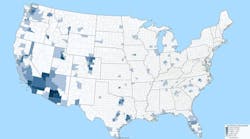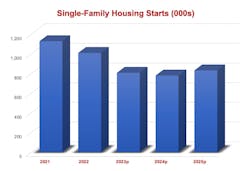The Ripple Effect of a Decline in Housing Starts
Higher interest rates and rising prices will translate into a decrease in housing starts in key counties around the U.S., according to a recent report by market forecasting firm Senex. The result will be a multi-billion-dollar drop-off in revenues in categories ranging from appliances to heating and cooling equipment to windows.
The twist in the tale: 80% of the declines in starts will be concentrated in just 284 of the more than 3,100 total counties across the U.S. A full 50% of the declines will be concentrated in a mere 65 of those counties.
The lesson here? Movements in a relatively small number of key markets around the country have an outsized impact on the performance of the overall domestic housing sector, either for good or for ill.
RELATED
- Advice for Home Builders Navigating a Housing Market in Flux
- A Near Record Number of Housing Units Are Under Construction, but They’re Taking Longer to Complete
- Attainable Housing Options: Rethinking the Starter Home
County-Level Housing Starts Data
The latest numbers are staggering. For example, of the total 202,000-unit projected decline in single-family housing starts, those 284 counties will account for 161,600 of them.
Those counties also will account for $51.2 billion of the total $64 billion in lost revenue the housing sector will suffer this year. The remaining $12.8 billion in losses will be spread over the remaining 2,928 counties. To put these numbers into perspective, the total gross domestic product (GDP) of Montana in 2022 was $65 billion.
As for the rest of the U.S., the remaining 2,861 counties will definitely experience fewer starts, but will only average a decline of about 20 units each. The map below illustrates the concentration of single-family construction in U.S. counties. Darker shaded counties will experience the biggest declines. Unsurprisingly, the hardest hit counties also happen to be the same ones that benefitted from most of the growth during the past three years.
Most of the counties represented here are found in states where building has comprised half of all starts in past years. These 10 states will account for more than 136,000 fewer starts in 2023, which obviously translates into a much bigger hit to each state’s economic growth and tax revenue.
Impact on Pricing and Materials Costs in Home Building
Trace all that money backward from the point of sale to the installers, dealers, distributors, manufacturers, and raw materials suppliers and it’s easy to see why so many housing sector workers—especially the ones serving these critical markets—are looking to the future with concern.
An analysis of these individual markets provides a clearer picture of what higher interest rates and the rising costs of doing business have done to builders, manufacturers, and others affected by the shifts.
According to the latest U.S. Census Bureau data, the average sales price of a new home in April 2023 was $501,000. Our estimate—based on discussions with home builders and other research sources—is that it costs $315,000 to build an average-priced home, excluding land and related fees.
RELATED
- Housing Starts Rose in April but Are Still Down Significantly From a Year Ago
- Where Are Single-Family Housing Starts Falling the Fastest?
- 2023 Housing Forecast: Positive Outlook
Builders also told us they are currently seeing, and are budgeting for, even higher prices for building products and materials. Carlos Fulton, a custom builder in Dallas, says costs for his new homes are going up even as demand is falling. “It’s not like prices are falling for me where I can pass along savings to my buyers through a lower sales price,” he says. “They just keep going higher.”
Senex validates his experience. Our numbers predict, at least through May of 2023, the estimated cost-to-build is going to climb despite falling demand for new homes.
That means there will be no relief in the short term for the ailing housing sector. Here's a sense for just how many dollars will disappear in various product categories with the predicted drop in single-family construction: The HVAC segment will lose $2.3 billion in revenue, followed by windows (–$1.5 billion), major appliances (–$700 million), toilets (–$615 million), kitchen and bath faucets (–$465 million), and doors (–$250 million).



